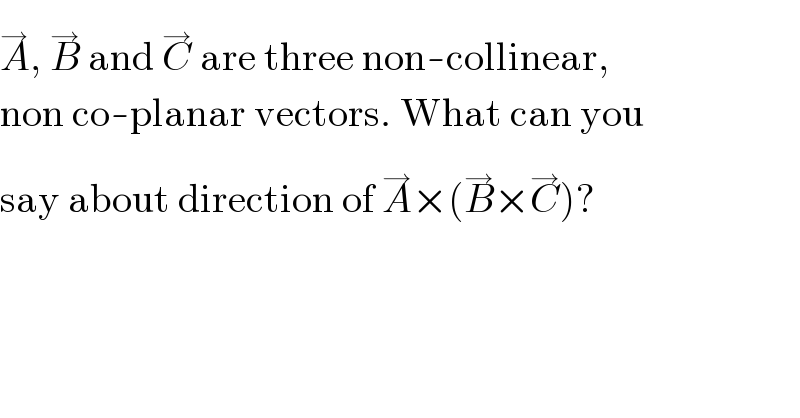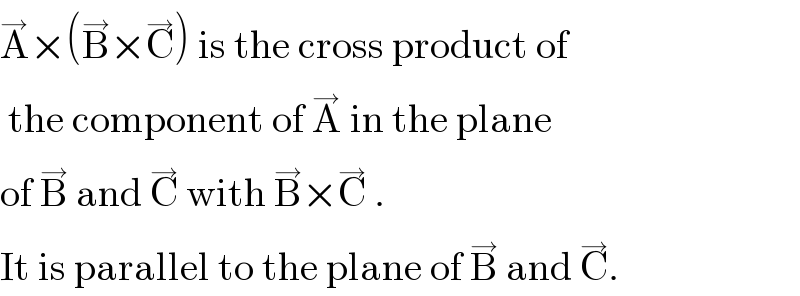
Question Number 18094 by Tinkutara last updated on 15/Jul/17

$$\overset{\rightarrow} {{A}},\:\overset{\rightarrow} {{B}}\:\mathrm{and}\:\overset{\rightarrow} {{C}}\:\mathrm{are}\:\mathrm{three}\:\mathrm{non}-\mathrm{collinear}, \\ $$$$\mathrm{non}\:\mathrm{co}-\mathrm{planar}\:\mathrm{vectors}.\:\mathrm{What}\:\mathrm{can}\:\mathrm{you} \\ $$$$\mathrm{say}\:\mathrm{about}\:\mathrm{direction}\:\mathrm{of}\:\overset{\rightarrow} {{A}}×\left(\overset{\rightarrow} {{B}}×\overset{\rightarrow} {{C}}\right)? \\ $$
Commented by ajfour last updated on 15/Jul/17

$$\overset{\rightarrow} {\mathrm{A}}×\left(\overset{\rightarrow} {\mathrm{B}}×\overset{\rightarrow} {\mathrm{C}}\right)\:\mathrm{is}\:\mathrm{the}\:\mathrm{cross}\:\mathrm{product}\:\mathrm{of} \\ $$$$\:\mathrm{the}\:\mathrm{component}\:\mathrm{of}\:\overset{\rightarrow} {\mathrm{A}}\:\mathrm{in}\:\mathrm{the}\:\mathrm{plane} \\ $$$$\mathrm{of}\:\overset{\rightarrow} {\mathrm{B}}\:\mathrm{and}\:\overset{\rightarrow} {\mathrm{C}}\:\mathrm{with}\:\overset{\rightarrow} {\mathrm{B}}×\overset{\rightarrow} {\mathrm{C}}\:. \\ $$$$\mathrm{It}\:\mathrm{is}\:\mathrm{parallel}\:\mathrm{to}\:\mathrm{the}\:\mathrm{plane}\:\mathrm{of}\:\overset{\rightarrow} {\mathrm{B}}\:\mathrm{and}\:\overset{\rightarrow} {\mathrm{C}}. \\ $$
Commented by ajfour last updated on 15/Jul/17

Commented by Tinkutara last updated on 15/Jul/17

$$\mathrm{Thanks}\:\mathrm{Sir}! \\ $$
